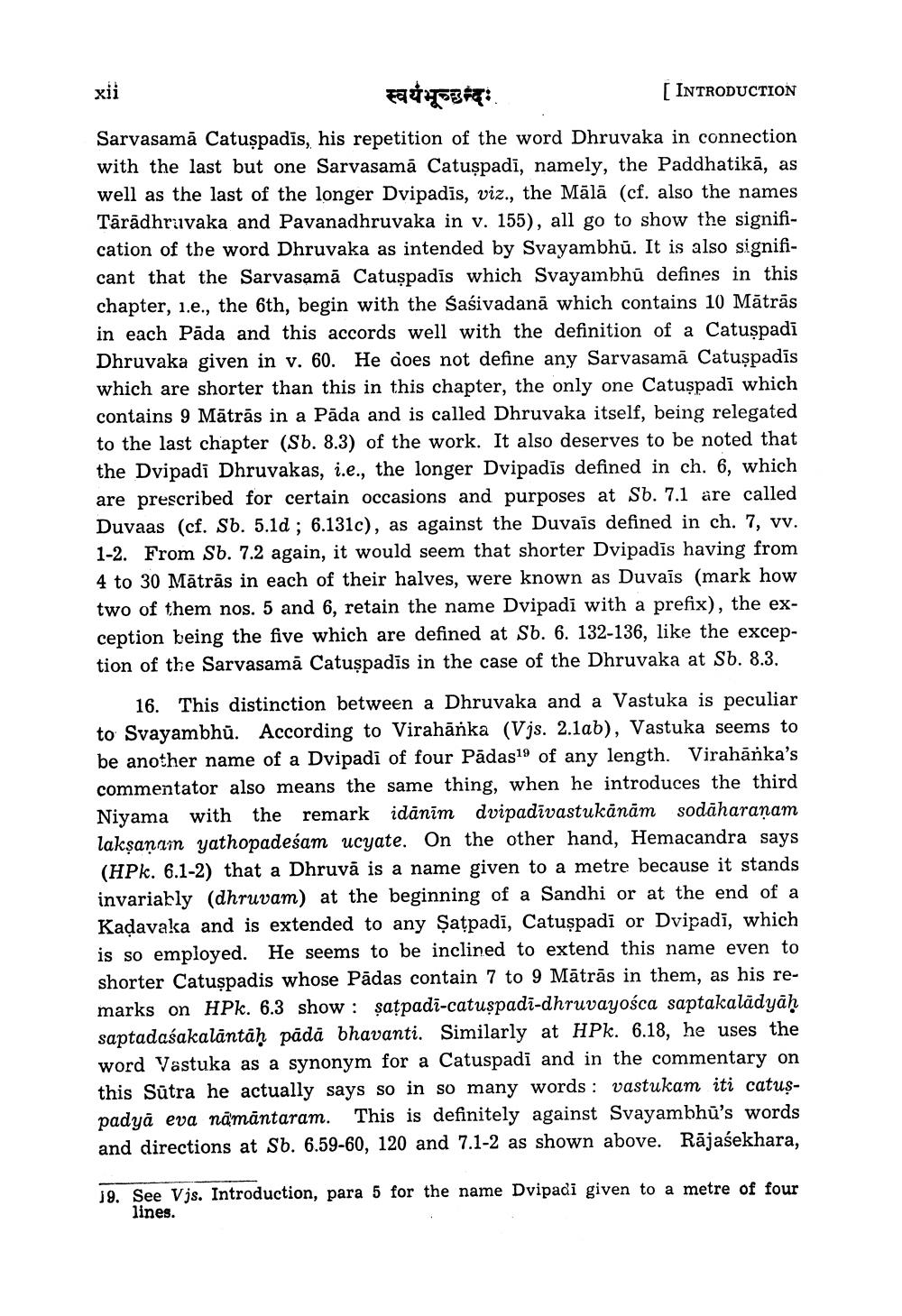________________
xii
स्वयंभूच्छन्दः
[INTRODUCTION
Sarvasamă Catuspadis, his repetition of the word Dhruvaka in connection with the last but one Sarvasamā Catuspadi, namely, the Paddhatikā, as well as the last of the longer Dvipadis, viz., the Mālā (cf. also the names Tārädhruvaka and Pavanadhruvaka in v. 155), all go to show the signification of the word Dhruvaka as intended by Svayambhū. It is also significant that the Sarvasamă Catușpadīs which Svayambhū defines in this chapter, 1.e., the 6th, begin with the Saśivadanā which contains 10 Mātrās in each Päda and this accords well with the definition of a Catuspadi Dhruvaka given in v. 60. He does not define any Sarvasamă Catuspadis which are shorter than this in this chapter, the only one Catuspadi which contains 9 Mātrās in a Pāda and is called Dhruvaka itself, being relegated to the last chapter (Sb. 8.3) of the work. It also deserves to be noted that the Dvipadi Dhruvakas, i.e., the longer Dvipadis defined in ch. 6, which are prescribed for certain occasions and purposes at Sb. 7.1 are called Duvaas (cf. Sb. 5.1d ; 6.131c), as against the Duvais defined in ch. 7, vv. 1-2. From Sb. 7.2 again, it would seem that shorter Dvipadis having from 4 to 30 Mātrās in each of their halves, were known as Duvais (mark how two of them nos. 5 and 6, retain the name Dvipadi with a prefix), the exception being the five which are defined at Sb. 6. 132-136, like the exception of the Sarvasamă Catuspadis in the case of the Dhruvaka at Sb. 8.3.
16. This distinction between a Dhruvaka and a Vastuka is peculiar to Svayambhū. According to Virahānka (Vjs. 2.1ab), Vastuka seems to be another name of a Dvipadi of four Pādas19 of any length. Virahānka's commentator also means the same thing, when he introduces the third Niyama with the remark idānim dvipadīvastukānām sodaharanam lakṣaṇain yathopadeśam ucyate. On the other hand, Hemacandra says (HPk. 6.1-2) that a Dhruvā is a name given to a metre because it stands invariably (dhruvam) at the beginning of a Sandhi or at the end of a Kadavaka and is extended to any Şațpadi, Catușpadi or Dvipadī, which is so employed. He seems to be inclined to extend this name even to shorter Catușpadis whose Pādas contain 7 to 9 Mātrās in them, as his remarks on HPk. 6.3 show : satpadī-catuspadi-dhruvayośca saptakalădyāḥ saptadaśakalāntāḥ pādā bhavanti. Similarly at HPk. 6.18, he uses the word Vastuka as a synonym for a Catuspadi and in the commentary on this Sūtra he actually says so in so many words: vastukam iti catuspadyā eva nāmāntaram. This is definitely against Svayambhū's words and directions at Sb. 6.59-60, 120 and 7.1-2 as shown above. Rājasekhara,
19. See Vjs. Introduction, para 5 for the name Dvipadi given to a metre of four
lines.




